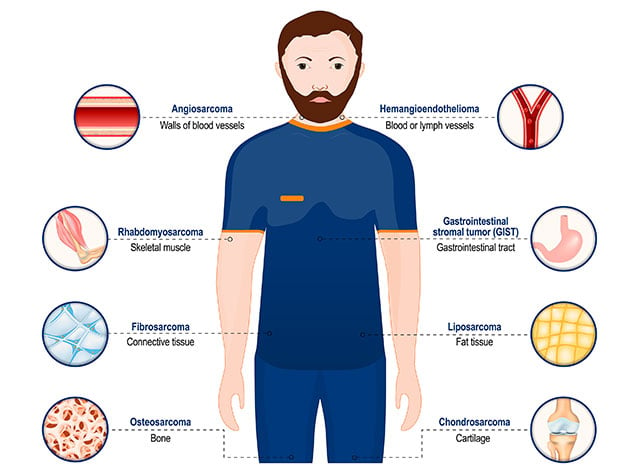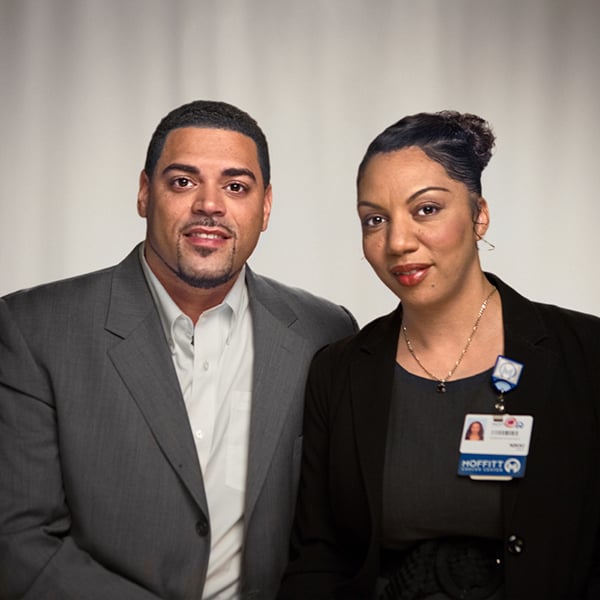Sarcoma FAQs

If you or a loved one has been diagnosed with sarcoma, it’s normal to have a lot of questions. Because sarcoma is a relatively uncommon cancer, it’s best to find an oncologist who has specific experience in diagnosing and treating the condition, as he or she will be best equipped to address your concerns.
As a high volume cancer center, Moffitt Cancer Center has a team of skilled oncologists who treat sarcomas with a significant level of frequency. We can use our expertise to help you determine the cause of your symptoms, understand what your diagnosis means and explain what options you have for treatment. A physician’s referral is not required to schedule a consultation.
Contact us today to schedule an appointment. Call us at 1-888-663-3488 or request an appointment online.
What you need to know about your sarcoma diagnosis
The following FAQs can help you better understand sarcoma:
- Questions to ask your sarcoma specialist
Your sarcoma specialist is an excellent resource for providing answers to your questions. You should talk to him or her about any concerns you have. It’s a good idea to write your questions down, so you don’t forget anything. You can ask questions about your diagnosis, treatment options, side effects, treatment recovery, etc. - When should I see a sarcoma specialist?
If you are experiencing symptoms, you should talk to your physician, who can help you determine if you could benefit from seeing a sarcoma specialist. It is a good idea to see a sarcoma specialist if a lump or swelling has developed in your arm, leg or abdomen, your bones have been aching for days, you’re having difficulty walking or you have developed an unexplained limp. - What is a soft tissue sarcoma?
A soft tissue sarcoma is a type of cancer that forms in muscle, ligament, tendon, synovial membrane, nerve or blood vessel – soft tissues that connect and support other structures in the body. Soft tissue sarcomas can develop anywhere in the body, but they most often occur in the head, neck, abdomen, arms or legs. - What are the different types of sarcoma?
There are two main types of sarcoma. Soft tissue sarcomas develop in soft tissues like muscles, blood vessels or ligaments. The second main type is bone sarcoma. Within those two main types of sarcoma, there are more than 70 subtypes, named for the type of tissue or bone they form in. For instance, fibrosarcoma develops in fibrous tissue, and liposarcoma develops in fatty tissue. - How long after diagnosis should I be treated for sarcoma?
The earlier you can begin treatment after receiving your sarcoma diagnosis, the better. The sooner treatment begins, the less time cancer has to grow. Different types of treatment are available for sarcoma – the treatment used and the length of treatment will vary from patient to patient. - What are the most common sarcoma symptoms?
Because sarcoma can develop anywhere in the body, symptoms vary from person to person. Sarcoma tumors can sometimes be seen beneath the skin; however, not all sarcomas cause lumps. Many symptoms are going to be specific to where the sarcoma develops. For instance, a sarcoma in the lungs may cause difficulty breathing, whereas a sarcoma in the uterus may cause vaginal bleeding. - Am I at risk for developing sarcoma?
There are certain factors that are known to increase a person’s risk for developing sarcoma. Some sarcoma risk factors are genetic, while others are acquired over time. Genetic disorders that increase risk for developing sarcoma include retinoblastoma, familial adenomatous polyposis and Werner syndrome, among several others. Some non-genetic risk factors for sarcoma include prolonged exposure to ionizing radiation or chemicals including vinyl chloride, arsenic and dioxide. - What are the most common types of sarcoma?
The most common types of sarcoma are soft tissue sarcomas, including angiosarcomas, fibrosarcomas, leiomyosarcomas, rhabdomyosarcomas, liposarcomas and synovial sarcomas. Osteosarcomas (bone sarcomas) are second most common to soft tissue sarcomas, with the least frequent type being sarcomas that develop in internal organs, such as the lungs. - What causes sarcoma in adults?
The exact causes of sarcoma – and other types of cancer – are unknown. But scientists believe that, like other forms of cancer, sarcoma can develop from DNA mutations that affect genes that are responsible for regulating cell growth. These DNA mutations can be genetically inherited, or they can be acquired over time. - Where can sarcoma spread to?
As sarcoma advances to late stages, it can metastasize, or spread, to other parts of the body. The most common place for sarcoma to spread is the lungs. However, stage 4 sarcoma could also spread to other soft tissues, the liver, skin or lymph nodes. - What is osteosarcoma of the jaw?
Sarcoma is a type of cancer that affects the body’s connective tissues—the bones, cartilage, muscles, tendons, ligaments, fat, skin, nerves and blood vessels. Approximately 6% to 7% of osteosarcoma cases occur in the jawbone.
If you’d like to discuss your concerns in person, call 1-888-663-3488 or submit a new patient registration form online to request an appointment at Moffitt.

"My first experience it sounded like there was no hope. And when I came to Moffitt it was a totally different experience where there was hope, you know. There was going to be a silver lining at the end of all of this. And I was going to win."
Kevin, Sarcoma Survivor
Request an Appointment